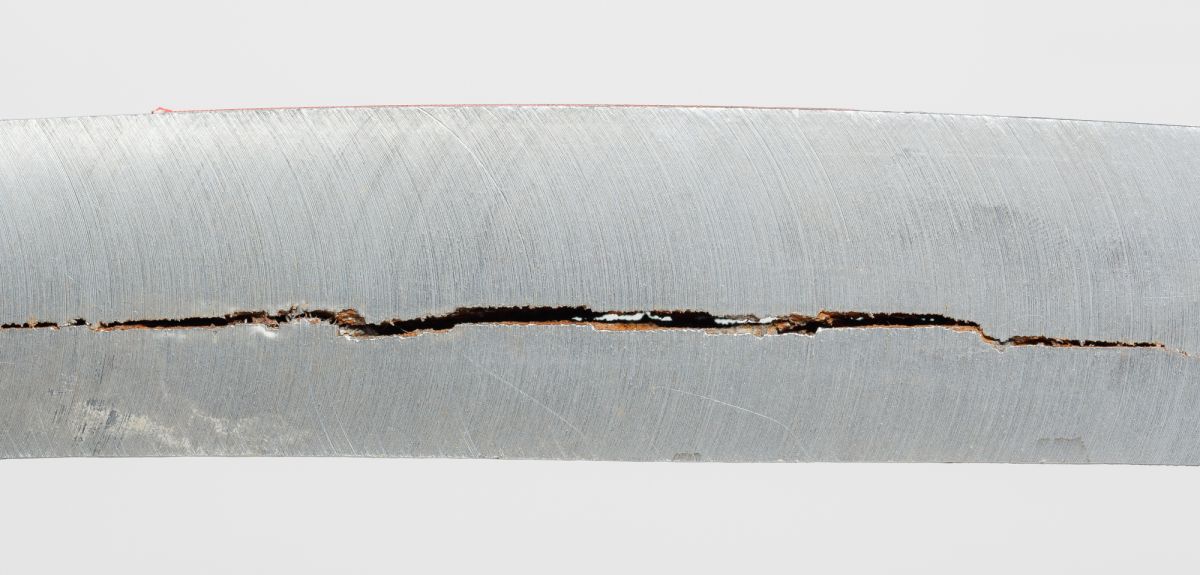
Image credit: CEphoto, Uwe Aranas under Creative Commons license
How can engineers make steel that doesn't baulk at hydrogen?
For over 100 years engineers have known that hydrogen can cause metals to become incredibly brittle, but they've been able to do little to protect against it. Now, Oxford University researchers are working on a large collaborative project to build the metals of the future, that can retain their strength in the presence of this disruptive gas.
Steel has a reputation for being strong: it's used in everything from your car's chassis and the reinforced concrete joists that supports buildings, to the internal workings of jet engines and the cables that hold up the world's largest suspension bridges. But while advances in high-strength steel technology theoretically allow engineers to use less of the material – making it possible to create structures that are lighter as well as stronger – there exists a problem holding some of the materials back from widespread adoption.
'There are new materials sitting on the shelf that could be used for many kinds of applications – construction, aerospace, cars, all sorts,' explains Professor Alan Cocks from the University's Department of Engineering Science. 'But companies are afraid to use some of them because of their susceptibility to what's known as hydrogen embrittlement.' First observed before the turn of the 20th century, hydrogen embrittlement is a phenomenon where some materials – particularly steel, but also metals like zirconium and titanium – become far weaker when exposed to hydrogen.
Professor Cocks points out that some steels can suffer a decrease in strength by as much as a factor of 10 when they're exposed to hydrogen, which means that they could fail when subjected to just a tenth of the maximum stress they can usually withstand. If engineers could find a way to overcome this weakness, they could more confidently use some materials – predominantly steels, but also the likes of titanium for aerospace applications or the zirconium sheathing of nuclear power rods.
'It seems like it should be a straightforward problem to solve,' explains Professor Cocks. 'But there's immense controversy about why it happens, and despite lots of experimental studies and theoretical modelling there's still no real solution.' That's why researchers from Oxford University are working on a large collaborative project – along with Cambridge University, Imperial College London, King's College London and the University of Sheffield – to finally understand its causes and build new materials that overcome them.
To make progress, the researchers decided to put together a team that understood metals from the atom up. So the team includes Oxford scientists from the Department of Materials, who investigate how materials work at the atomic level, and from the Department of Engineering Science, who model the larger-scale properties of the materials and the ways that hydrogen can move through the metallic structure. Elsewhere around the UK there are teams that specialise in different aspects of modelling, as well as the design, fabrication and testing of new metals.
Just over a year into the project, the Oxford team are trying to understand exactly how hydrogen causes steel to become brittle. There are, broadly speaking, two competing schools of thought. The first suggests that the hydrogen atoms build up around tiny defects called dislocations in the metal's crystal structure, affecting the way the material irrevocably deforms. The second proposes that instead the hydrogen gathers at boundaries between chunks of metallic crystal known as grains, making it easier to pull them apart. 'We suspect it could be a combination of both,' admits Professor Cocks. 'But by modelling the process at different scales, we hope to find out once and for all.'
At the same time, the Oxford engineers are also proposing new ways to help steels cope in the presence of hydrogen. 'In the past, people have used coatings to protect against hydrogen being absorbed by metals,' points out Professor Cocks. 'But if you get a crack in that coating, you expose the material underneath. And anyway, because of its size, hydrogen can ultimately diffuse through any material, so a coating will only ever slow down the process.'
Instead, the team is seeking to develop a series of internal traps that can capture the hydrogen as it enters the metal. 'You can think of them as little sponges in the steel that mop up all the hydrogen so that it's not detrimental to the material properties,' explains Professor Cocks. So far the team has been studying how carbides – a type of carbon-metal compound – can be used within the microstructure of metals to such ends, because hydrogen appears to gravitate towards boundaries between them and grains of iron. The team hope that once they move to this boundary, the hydrogen will sit there benignly.
There are, of course, still plenty of questions that need to be answered before such techniques calm the minds of engineers keen to use these kinds of materials. Not least among them is what happens to the hydrogen stored within those traps: it may affect the material properties in an unexpected way. But that's why fellow collaborators in Sheffield and Cambridge are taking the work performed in Oxford, and by other partners, as a blueprint from which they can design and fabricate new types of steel to test in the lab.
Given the team has so far only spent just over a year's work trying to solve a problem that's persisted for over a century, you might not expect much progress so far. 'There are certainly a lot of challenges,' concedes Professor Cocks. 'But we think we're finally getting close to a point where everything will fall into the right place.' Much, one hopes, like the hydrogen itself.
HEmS is funded by the Engineering and Physical Sciences Research Council (EPSRC). It is a joint collaboration between the Universities of Oxford, Cambridge, Sheffield, and Imperial and King's Colleges London.